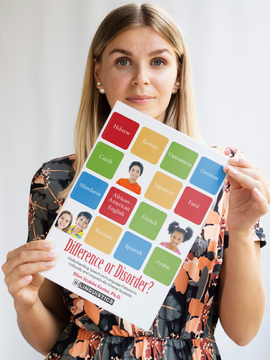Identify Appropriate Articulation Targets for Second-Language Learners
$15.00

Course Type: Video – 1 hour
ASHA Course Code: Diversity, Equity, and Inclusion in Education, Training, Service Delivery, Public Policy – 7030
Improve articulation therapy with English-language learners by identifying appropriate targets. Easily use common tools such as Venn Diagrams and the Goldman-Fristoe Test of Articulation to differentiate between true sound errors and second-language influences. In this presentation we will use Spanish as an example to explore how sounds develop when a second language is present.
Additional Information
| Population | Early Childhood, School Age |
|---|---|
| Topics | Articulation/Phonology, Diversity, Equity, & Inclusion (DEI) |
| Duration | 1 hour |
| Credit | .1 Continuing Education Unit |
| Format | Video |
Financial Disclosure: Ellen Kester, Ph.D., CCC-SLP. Dr. Ellen Kester is the owner of Bilinguistics and receives a salary. Bilinguistics receives royalty payments for online courses.
Non-Financial Disclosure: Ellen Kester does not have any non-financial relationships to disclose.
Financial Disclosure: Scott Prath, M.A., CCC-SLP is a salaried employee of Bilinguistics. Bilinguistics receives royalty payments for online courses.
Non-Financial Disclosure: Scott Prath does not have any non-financial relationships to disclose.
This course demonstrated how to improve articulation therapy with English language learners by identifying appropriate targets. We used tools, such as Venn diagrams and the Goldman-Fristoe Teat of Articulation, to differentiate between true sound errors and second-language influences. This course explored 12 languages including, Spanish, Mandarin, Chinese and Vietnamese.
As children begin to understand the world around them, they learn to conceptualize the objects in their environment and communicate about them using commonly accepted names. The organization of these concepts grows more complex as children mature and as their experiences widen.
In order to better understand this phenomenon, researchers have investigated how children generate word names in response to different types of categories in varying conditions. Nelson and Nelson (1990) suggested that children first organize concepts in a highly contextualized, script-based categorization style, (e.g., foods we eat for breakfast). This is learned based on the daily routines in their environment. As their experiences broaden, Nelson and Nelson (1990) hypothesize that children become less dependent on context (e.g. the meal) as they begin to synthesize their experiences across contexts into general categories (e.g food). Understanding how children organize such knowledge provides insight into the development of their lexical naming ability.
Similarly, Crystal (1998) suggests that lexical learning requires adjusting one’s semantic structure to find a place for the newly learned item within the existing lexicon. For example, a child may first learn to distinguish between different foods as the parent helps the child focus on key similarities and differences, such as taste, color, and shape, during the daily lunchtime dialogue to help them reorganize their vocabulary.
Assessing lexical knowledge helps speech-language pathologists and other educators understand a child’s language ability. In the field of speech-language pathology, single-word picture vocabulary tests have traditionally been used to assess lexical development for the purpose of diagnosing language impairment. However, these measures have been criticized for failing to reflect these important changes in semantic structure and organization.
Clinicians and researchers alike have questioned the construct validity, diagnostic accuracy, and appropriateness of using these measures with a variety of populations (Channell & Peek, 1989; Furlong & Teuber, 1984; Gray, Plante, Vance & Henrichsen, 1999; Johnston & Bowman, 1990; Kutsick, Vance, Schwarting, & West, 1988). For this reason, clinicians and researchers have started to use broader measures of vocabulary that may include descriptive information, similarities and differences in objects, synonyms, antonyms, and categorization to get a more thorough understanding of word knowledge.
Participants will:
Apply a systematic framework to the speech assessment of second-language learners.
Identify speech characteristics of foreign languages that are consistent with English.
Analyze and interpret articulation test results of English language learners.
Differentiate between speech errors that result from impairment and errors that result from second-language influence.
Time-Ordered Agenda:
05 minutes Introduction
15 minutes A framework for the speech assessment of second-language learners
15 minutes Speech characteristics of foreign languages that are consistent with English
10 minutes Analysis and interpretation of articulation test results of English language learners
10 minutes Differentiation of speech errors that result from impairment and errors that result from second-language influence.
05 minutes Summary and questions
Need CEUs?

 Share
Share
 Tweet
Tweet
 LinkedIn
LinkedIn
 Pin
Pin
 Email
Email







